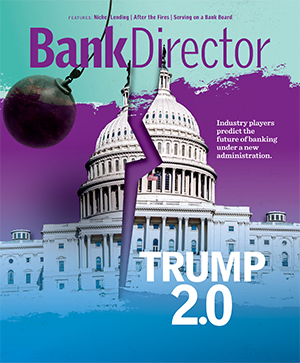David Tinsley is a seasoned professional with over 20 years of commercial banking experience, specializing in SBA products. As the Senior Vice President and Head of SBA LSP Services at Lenders Cooperative, David leads a dedicated team focused on providing exceptional lending services to small businesses. Throughout his career, David has developed extensive expertise in SBA products. He previously spent 11 years at Regions Bank, where he led various SBA 7a units, demonstrating his ability to drive success and innovation in the lending space.

Embracing SBA Lending in Difficult Times
With the right expertise, partners and technology, SBA lending can become a seamless and profitable extension of your bank’s lending strategy.
Brought to you by Lenders Cooperative

When uncertainty strikes, the tendency of every risk manager is to tighten credit parameters, effectively closing the credit box in the process. We’ve seen it time and time again — whether during economic downturns, market volatility or regulatory shifts.
The instinct to pull back is understandable, but in doing so, you risk sending the message to your customers that you are not as interested in being their financial partner. As a result, those customers feel as if they are being pushed toward alternative lenders that charge high rates and often lack the personalized support small businesses need.
Instead of retreating, banks should be doubling down on a proven solution: Small Business Administration lending. The SBA’s loan programs provide banks with a powerful way to serve small businesses while mitigating risk. The SBA’s guaranty reduces exposure, making it an ideal tool for banks to extend credit when they might otherwise hesitate. More importantly, it enables banks to strengthen their relationships with small-business clients, capturing a customer base that is not only massive but eager for local banking relationships.
The Opportunity
Small businesses are the backbone of the U.S. economy. According to the U.S. Small Business Administration, there are 33 million small businesses in the U.S., accounting for 44% of economic activity and nearly half of all U.S. jobs. Despite their scale and significance, small businesses continue to struggle with access to capital, particularly during times of financial tightening.
A recent survey by Lumos Data uncovered a critical disconnect. Small businesses want to bank with their local institutions, but they often can’t get the financing they need from them. When turned away, they are forced to seek funding from alternative lenders — many of whom charge exorbitant rates and lack the relationship-focused approach that small-business owners value.
Here’s the reality: Your customers are going elsewhere, but they aren’t happy about it. The question is: Why wouldn’t you serve them yourself?
Why Banks Hesitate
Despite the clear demand, many banks still avoid SBA lending. When asked why, institutions typically cite the following five reasons:
- “We don’t have the internal expertise.”
- “We’ve had bad experiences with SBA loans in the past.”
- “The process is too complex and time-consuming.”
- “We don’t have the staffing to manage it.”
- “We don’t see enough demand.”
Each of these concerns is valid, but none are insurmountable. Banks that have successfully implemented SBA lending have done so by leveraging third-party SBA loan service providers (LSPs) that specialize in managing the process, ensuring compliance and streamlining operations. These partnerships eliminate the burden of SBA lending while allowing banks to capture significant lending opportunities without materially increasing their risk.
The Power of SBA Lending
A well-run SBA business line can transform a bank’s commercial lending strategy. By implementing an SBA lending program, banks can:
- Expand credit access while mitigating risk through government guarantees.
- Strengthen relationships with business clients by meeting their financing needs.
- Capture nontraditional borrowers who might not qualify for conventional loans.
- Increase fee income and profitability through SBA loan incentives.
- Enhance community impact by supporting job creation and economic growth.
Banks that actively participate in SBA lending don’t just help their customers — they future-proof their own lending portfolios.
SBA Lending in 2025
As economic uncertainty continues to shape the lending landscape, SBA lending represents an opportunity that banks can’t afford to ignore. Small businesses are actively looking for partners who understand their needs and provide capital on fair and sustainable terms. If your bank isn’t offering SBA loans, you’re not just missing out on business — you’re pushing your customers toward high-cost lenders who will gladly take them off your hands.
The good news? It’s easier than ever to get started. With the right expertise, partners and technology, SBA lending can become a seamless and profitable extension of your bank’s lending strategy.
Small businesses need you. The only question is: Will you step up to serve them?


